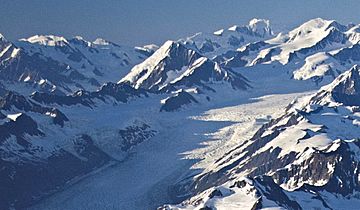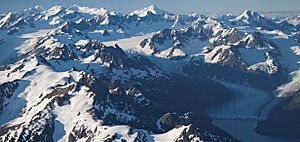Mount Glenn (Alaska) facts for kids
Quick facts for kids Mount Glenn |
|
|---|---|

Mt. Glenn centered with Yale Glacier featured
|
|
| Highest point | |
| Elevation | 9,806 ft (2,989 m) |
| Prominence | 2,006 ft (611 m) |
| Isolation | 3.52 mi (5.66 km) |
| Parent peak | Mount Witherspoon (12,012 ft) |
| Geography | |
| Location | Chugach National Forest Valdez-Cordova Borough Alaska, United States |
| Parent range | Chugach Mountains |
| Topo map | USGS Anchorage B-2 |
| Climbing | |
| Easiest route | Mountaineering |
Mount Glenn is a tall mountain in Alaska, standing at 9,806-foot (2,989 m) high. It's covered in glaciers, which are like huge, slow-moving rivers of ice. You can find it about 40 mi (64 km) northwest of a town called Valdez. This mountain is part of the Chugach Mountains, a large mountain range in the United States.
Mount Glenn is a remote peak, meaning it's far away from cities and towns. It sits north of Prince William Sound and is managed by the Chugach National Forest. It's also near other big mountains, like Mount Witherspoon, which is about 6.44 mi (10 km) away, and Mount Einstein, about 9.34 mi (15 km) away. Mount Glenn is part of the Dora Keen Range. This range is about 25 miles long and separates two large glaciers: the Harvard Glacier and the Yale Glacier. The mountain was named in 1911 by a geographer named Lawrence Martin. The name was officially recognized in 1930. It honors Edwin Forbes Glenn, an Army officer who explored this area in 1898. The Glenn Highway in Alaska is also named after him.
Mountain Climate
Mount Glenn is located in a subarctic climate zone. This means it has very long, cold, and snowy winters. The summers are usually mild, not too hot. The weather here is greatly affected by the Gulf of Alaska. When air from the Gulf moves inland, it hits the tall Chugach Mountains. This forces the air upwards, a process called orographic lift. As the air rises, it cools down, causing a lot of rain and snow to fall on the mountains.
Temperatures on Mount Glenn can drop very low, sometimes below −20 °C. With the wind, it can feel even colder, below −30 °C. This cold and snowy climate is perfect for the large glaciers that surround the mountain, like the Harvard and Yale Glaciers. If you want to visit or climb Mount Glenn, the best time is usually from May through June. The weather during these months is often more favorable and pleasant.



